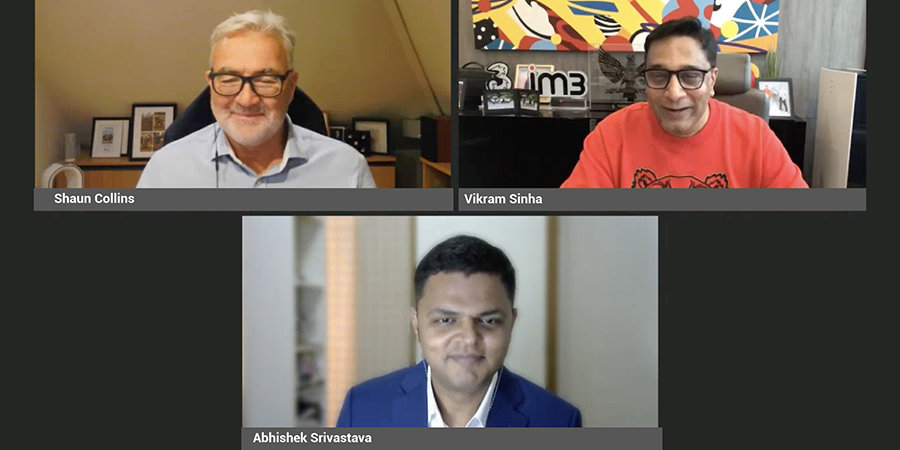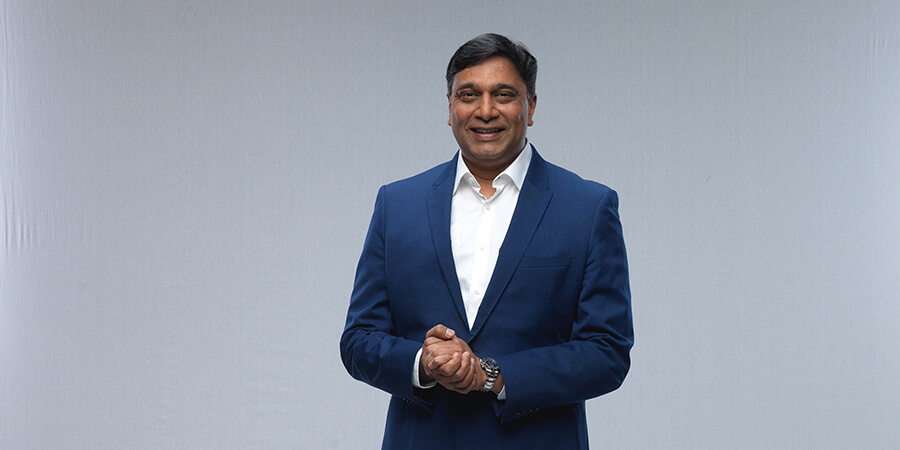Telecom Review Asia recently presented its first-ever webinar titled "Empowering Indonesia: The Impacts of a Successful Merger," which brought together distinguished speakers to shed light on the groundbreaking merger of Ooredoo Group and CK Hutchison to form Indosat Ooredoo Hutchison, along with the resulting impact on the dynamic Indonesian telco sector.
Abhishek Srivastava, principal and head of TMT, Arthur D. Little Southeast Asia, served as moderator for the panel, which featured notable speakers Vikram Sinha, President Director & CEO, Indosat Ooredoo Hutchison, and Shaun Collins, executive chairman, CCS Insight, who both provided their expertise and unique and insightful perspectives.

To set the context, Vikram provided some background about Indosat being a well-established brand in Indonesia with a history spanning 56 years. Notably, it was the first company to connect Indonesia to the rest of the world.
Indosat Ooredoo Hutchison (IOH) was formed in January 2022 through a successful merger. Since its inception, the company has seen much progress, including a market valuation increase to $5.1–5.2 billion. More significantly, it has prioritized sustainability and contributed to the country's medium- and long-term growth.
Key Opportunities and Investment Prospects
The first question highlighted how Indonesia is an optimal place to witness such a merger because of the current nature of the country’s market, which is one of the largest and most diverse in the world.
Collins pointed out that in any market, scale sells, and the company’s influence grows with size. This strategic advantage allows companies to build a tapestry of technologies that benefit the company and the nation, providing above-average returns on investment.
Since 5G is relatively new, Indosat and the Indonesian market have tremendous prospects. Collins highlighted that IOH’s operation and client base are large enough to capitalize on 5G technology, propositions and use cases.
Vikram noted that achieving success frequently depends on being in the right location at the right moment. The role of a telco with scale, sustainability and a dedication to providing assistance to the nation becomes very essential. Looking from a global perspective, Indonesia is well positioned to be one of the top 10 economies by the year 2030, driven mostly by rural Indonesia. In the next four years, it is anticipated that there will be 21 million new first-time internet users in rural Indonesia alone.
He further invited investors and partners to investigate the ways in which technology might be utilized to address genuine concerns and ultimately aid people in the country. With the appropriate mindset, this long-term benefit would be considerable. Because of its significant customer base, Indosat is in an advantageous position to navigate this opportunity by efficiently addressing the needs of its customers.
Effects on the Digital Landscape
When asked about the positive effects the merger has for the country’s digital landscape, Vikram highlighted that their primary objective has always been to improve the lives of all Indonesians, which is evident in the post-merger observations.
The average revenue per user (ARPU) has been a crucial indicator that demonstrates the influence of the merger, among other things. Following the completion of the merger, the ARPU increased from 8% to 15%. This, in turn, has been a contributing factor to the rise in revenue within the sector. The market had been expanding at a slow pace of 1-2% annually during the last five years before the merger took place. Looking ahead, a compound annual growth rate (CAGR) of five to 6% is expected, which is in line with the robust expansion of the GDP.
Moving beyond the merger and considering the bigger picture, IOH sees the possibilities offered by technologies such as 5G. But there is a significant amount of opportunity in 4G optimization as well. The company is focusing on the construction of rural networks and infrastructure with the goal of ensuring reliable connectivity.
Challenges in Wake of Merger
IOH’s merger might have been finalized earlier than expected, but it is not without its challenges. Asked about the hurdles telcos go through during mergers, Collins provided a world view wherein mergers across the globe are marked by challenges, particularly when integrating two large companies.
He explained that mergers can be seen in two dimensions: internal and external. He confided that internal factors may be more important. Combining two large, successful companies with established cultures and delivery methodologies is difficult. The issue is greater in Indonesia, as the people have distinct cultures. Cultural, methodological, and consumer alignments are key to such successful company mergers, which unite two possibly quite distinct techniques under a shared name and objective. The internal job includes developing the organization's identity and tackling simple but important concerns like brand delivery, distribution system management, and tariff policies.
Factors for a Successful Merger
For the fourth question, Vikram was asked about the indicators that contributed to the success of the merger, to which he responded that telcos must balance customer retention and synergy value during a merger. These worries stem from prior mergers that caused consumer losses and early financial hardships.
When faced with these obstacles, Vikram reminded himself about the company’s commitment to its customers. This underscored to him the value of people and culture, which are sometimes forgotten when putting so much focus on things other than people. Vikram further emphasized that a merger is more than a financial transaction; it’s an opportunity to impact the culture itself.
Pioneering Collaborative Strategies
When asked about IOH's pioneering strategies in their digital transformation journey and their alignment with the "Empowering Indonesia" mission, Vikram revealed that the concept for these strategies emerged during his earlier days while he was dedicated to empowering the youth in Indonesia.
This idea, deeply meaningful to him, was inspired by his experiences in rural Indonesia and is rooted in village culture. It underscores the strength of collective support to achieve more collectively and resonates with Indonesian culture. Vikram and his family, during the challenges of the COVID-19 pandemic in 2020, exemplified this philosophy by extending their help beyond their immediate circle.
Their goal is to collaborate with like-minded partners who share their principles, with the aim of creating a mutually beneficial and profitable partnership. They expect their partners to treat them fairly and contribute to Indonesia, unlocking the full potential of the country.
Vikram emphasized the importance of scale in making a significant impact and achieving the full potential of this vision, expressing his excitement toward this meaningful journey.
Fostering Innovation, Bridging the Digital Divide
In response to the question about how telcos can continue to enhance connectivity and foster innovation, particularly in underserved areas, Collins highlighted the global digital divide as a significant concern. He emphasized ongoing efforts aimed at addressing this issue through the utilization of various technologies and financing options, aligning with the UN's Sustainable Development Goals.
Collins further pointed out that connectivity technologies have evolved significantly with advancements in 5G, 4G, fiber and satellite technologies. These advancements have extended high-quality broadband and connectivity services to remote regions within Indonesia. He stressed the importance of fostering innovation in network deployment to raise awareness of the transformative potential of telecommunications and internet access, with a focus on creating comprehensive ecosystems that provide an enhanced user experience.
When serving underserved areas, Collins highlighted the need to leverage technology to solve real-world problems, aiming to cater to all 175 million Indonesians through a mix of such technologies, including 4G and satellites. Collaboration with like-minded partners was deemed essential, with a focus on achieving the right unit economics for sustainable growth. He underlined that the scope goes beyond mere connectivity and includes digital upskilling, addressing the digital talent gap and ensuring that the benefits of the digital transformation are accessible to all individuals.
IOH's Vision for Expanding Connectivity and Social Impact
Next up was a question about IOH's future initiatives for expanding its presence and creating a meaningful social impact. Vikram emphasized the company’s primary focus on providing exceptional connectivity experiences, not only in urban areas but also in remote regions. Their strategy prioritizes sustaining industry growth by building a solid foundation in essentials like efficient distribution, cost management and operational efficiency.
Financial prudence is seen as key to enabling investments in telecom capital expenditures. Vikram underlined the pivotal role of innovation in their approach, supported by global partners with various innovation labs in Silicon Valley and Jakarta, which foster partnerships to address real challenges.
He further shared their ambitious goal of achieving US$1 billion in digital revenue, constituting a significant part of their total revenue — a target of 15-20% by 2026. Their aim is to form partnerships that deliver value to both the company and Indonesia at large.
Vikram also emphasized the importance of incorporating fiber into their larger strategy, particularly in developed nations where aggressive implementation is feasible. Fiber, he noted, ensures a consistent and reliable broadband experience, and he observed that global operators are increasingly adopting it.
Vikram pointed out that spectrum availability and its efficient usage are game-changers, allowing for innovative approaches to the delivery of connectivity. Their approach encompasses a blend of fiber and fixed wireless access tailored to meet specific regional requirements, ultimately ensuring a seamless transition for customers as they switch between various connectivity solutions.
The company’s overarching focus, Vikram explained, is delivering marvelous experience by guaranteeing the seamless operation of technology in the background — achieving the right technology mix to cater to the diverse needs of a country like Indonesia.
Key Trends Shaping Digital Transformation in Indonesia
Looking ahead, Collins highlighted several key trends that will contribute to the advancement of digital transformation in Indonesia. He emphasized the importance of strategic partnerships with entities offering additional value, including cloud services, security and government collaborations, to fully unlock the potential of 5G networks and ensure a return on investment.
Collins underscored the significance of collaboration and scale in the industry, stating that larger organizations are better equipped to negotiate and collaborate with industry leaders, ultimately offering value to partners.
He also pointed out that flexibility and agility are paramount in adapting to the rapidly evolving telecommunications landscape, which is being driven by technologies like machine learning and IoT. This evolution is leading to the emergence of innovative technologies such as open RAN and core virtualization.
The convergence of computing and connectivity was dually noted as a significant trend, with Collins emphasizing the importance of making the right technology choices. He also stressed that sustainability remains a top priority, as large telcos have a significant economic and environmental impact. Therefore, a responsible approach to long-term goals, along with a focus on people integration and learning from past experiences, is critical for success in this ever-evolving industry.
Poll Questions
To cap off the webinar, Moderator Abhishek Srivastava posed four poll questions to the viewers, and the panelists gave their takes on each topic.
The audience was first asked what they thought was most essential for a successful merger. 50% responded that “customer experience management” is most important, 24% saw “strong leadership” as most vital and 13% held that “network integration” and “integrating workplace culture” are the most important factors for a merger to be successful.
For the second question, the audience was asked to choose which area is vital to digital transformation. The results showed 34% agreeing that having a strong cloud infrastructure is essential. A third question was about which aspects telcos should focus on to improve brand image, in which 78% of the audience answered “improved customer service and coverage,” while the remaining 22% answered “sustainable practices.”
The last question focused on the initiative Indonesia has to take in order to boost its digital economy. The poll results showed that 82% think “expanding coverage to underserved areas” should be the main priority, while 12% believe that Indonesia should “invest more in 5G.” The remaining 6% think that Indonesia should “advance digital literacy.”





